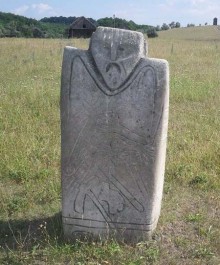Kharkiv activists have launched ethnic history and architecture-dedicated tours, gradually turning into the single Travel around Ukraine movement. With two several-days-long tours completed, they are now preparing for the third one and planning a few more educational tours to be conducted in the near future. The organizers, local historian Viktoria Skliarova and architect Denys Vitchenko, feel that “intellectual tours” is a most accurate designation for their project and thank The Day’s editor-in-chief Larysa Ivshyna who coined the name.
TASTING AND TOUCHING THE LAND’S SPIRIT
When talking about origins of the idea to launch ethnic tours involving in-depth coverage of history and architectural heritage exploration, Skliarova recalls The Day’s photo exhibition held at Kharkiv National
University in 2008, and the roundtable presided over by Ivshyna.
“I was already trying to organize ethnic tours at the time, and my story won a prize from the editor. It was then that I first heard that expression, ‘intellectual tours,’ from Ivshyna. It was to be about more than just consuming guide-provided information, about getting the real sense of the land which you are traveling around and its spirit.” Listening to and singing the old songs, tasting the local cuisine, drinking well water, even contacting local animals (once it was a marmots’ colony) and immersing oneself in spectacular landscapes – all these experiences Skliarova sees as elements of this type of travel, inspired by Ivshyna’s gift, the book Ukraine Incognita. The organizers stress that these tours are conducted not for profit but to bring together friends and like-minded people who feel similar love for the native land and desire to know its countless secrets. “Participants’ composition keeps changing because people’s interests vary,” Skliarova says. “Everyone finds some specific topic they like in our tours, so they go on one tour and pass on another.” It is also important that they lay out and use every route just once, so each tour is unique.
Earlier, Skliarova’s ethnic tours were influenced by the enthusiastic researcher from Kharkiv Mykhailo Krasikov’s “living local history” concept, following hearing an exciting story from him a decade ago about traveling kobza players of the Sloboda Ukraine. However, the travel movement grew really strong after this January’s addition of the historical and architectural component to ethnic content. Having met during the “Vasyl Krychevsky’s Kharkiv” tour, Skliarova the local historian and Vitchenko the architect have pooled their knowledge bases, made a series of educational radio broadcasts for a local radio station, and the tours very quickly became reality.
FROM KHOLODNY YAR TO KAMIANA MOHYLA
“Every journey begins with a dream,” Skliarova insists. So did the first tour, conducted this May and called “Architectural Gems of Siveria and Sloboda Ukraine” (let us recall that Den covered it in its No. 90 on May 29, 2013). The second tour, named “Between the Dnipro and the Tiasmyn: Looking for the Origins of the Cossack Statehood,” occurred in the last days of June. A 20-people-strong group traveled through Kholodny Yar valley, visited Chyhyryn, Subotiv, Melnyky, and Cherkasy. The travelers got to see a Ukrainian Modernist building in Kremenchuk, a Baroque church in Zolotonosha and met pleasant surprises in the form of unplanned meetings with interesting and dedicated people who were proposing new approaches to history of these places, their architectural gems and famous people. For instance, the travelers met with local historian Larysa Vysotska at a tiny billiard house in the town of Kamianka, erstwhile gathering place of the Decembrists, and she had some incredibly interesting stories to tell about the Decembrists and their families. She also covered the history of the Kholodny Yar Republic, a people’s war episode in the early 1920s Ukraine. “She was such a professional and emotional speaker!” Skliarova recalls. “We felt like we were unexpectedly experiencing these events there, at the Kamianka museum.” The tour participants visited a dilapidated parish church in the village of Nosivka, originally built in the Gothic style as a Polish Catholic church. The parish’s deacon by the name of Mykhailo, a historian by training but an architect by calling, created a huge collection of highly detailed models of palaces and ancient manor houses located in the area. “People with similar interests must cling together and create their own space,” the fantastic builder assured his guests.
The tours’ creative atmosphere prompts their participants to collaborate in laying out new routes. Ideas to make a visit to this or that interesting place, long desired by many, are born literally on the bus on the way back. It turned out that dreams can easily come true, provided that desires and efforts go together. The local historians are currently preparing the next tour called “The Eternal Beauty of Sloboda Ukrainian Landscapes through the Eyes of Vasyl Krychevsky.” The journey will take two days with a stop at the ethnic farmstead in Opishnia with windows overlooking the panorama of the ancient Romny settlement. Another tour is coming soon, too, calling for travelers to visit Kamiana Mohyla, Khortytsia, and Biriuchy Island in the Sea of Azov. The route will pass through Novomoskovsk where the local historians will visit a church built in the Cossack Baroque style.







